ISSN ONLINE(2319-8753)PRINT(2347-6710)
ISSN ONLINE(2319-8753)PRINT(2347-6710)
Sudarsana Rao.Hunchate1, Sashidhar.Chandupalle2, Vaishali.G.Ghorpode3 and Venkata Reddy.T.C4
|
| Related article at Pubmed, Scholar Google |
Visit for more related articles at International Journal of Innovative Research in Science, Engineering and Technology
High Performance Concrete (HPC) now a days used widely in the construction industry world wide. To produce HPC with normal ingradients we use mineral admixtures like Silica fume, fly ash and metakoline and workable agents Superplasticizers are also used. The usage of mineral admixtures in the concrete not only enhances its strength properties but also durability. The compressive strength are investigating finding the optimum use of mineral admixture( Silica fume of levels 0, 5, 10,15, 20 and 25% at 7 days and 28 days of curing). The present investigation aims to give design mix for HPC by using silica fume and superplasticizers.
Keywords |
| High Performance Concrete, Silica Fume, Superplasticizer and Compressive Strength. |
INTRODUCTION |
| High performance concrete (HPC) exceeds the properties and constructability of normal concrete. Normal and special materials are used to make these specially designed concrete that must meet a combination of performance requirements. HPC are made with carefully selected high quality ingredients and optimized mixture designs. HPC will have a low water cement ratio of 0.2 to 0.45. Super Plasticizers are usually used to make these concretes fluid and workable. HPC almost always has a higher strength than normal concrete. There are many methods of mix design for HPC. The methods proposed by ACI[1], Aitcin[2], Islam Laskar and Talukdar[3] are some methods. In the above methods, the first importance is given to selection of water-binder ratio(w/b) for a given targeted strength, even though the w/b ratio is not a very good predictor of compressive strength of HPC, the use of admixture like silica fume with a superplasticizer as workable agent is now an usual way to obtain high-performance concrete. VinayagamP [4] conducted experiments with silica fume and superplasticizers on high performance concrete with replacement of silica fume 0 to15% and the HPC mixes are tested experimentally for workability, compression, split tension and flexure and concluded that the performance of the design mixe are very good. Hooton [5] conducted experiments on replacement of cement with silica fume and studied physical properties and durability properties like freezing, thawing, sulphate attack and alkali-silica reactivity. He concluded that 28 days compressive strength was maximum at 15% silica fume replacement at a w/b ratio of 0.35 with variable dosage of superplasticizers. Yogendran and Langan [6] investigated on high-strength silica fume concrete at a w/b ratio of 0.34 and percentage of replacement of silica fume 0 to 25, with the varying dosage of superplasticizer and reported that maximum replacement level of 15%. Annadurai and ravichandran [7] conducted experiments for mix design of high strength concrete with admixtures, varying superplasticizer with a range 0.6 to 0.9% with an increment of 0.1% and concluded that addition of silica fume increases compressive strength and decreases the slump. Shreekedar and Kumbhar [8] studied the effect of mineral admixtures in mix proportioning of HPC, micro silica is replaced by weight of cement along with suitable super plasticizer, and concluded that better strengths are achieved for 15% replacement . |
RESEARCH SIGNIFICANCE |
| The main objective of this present investigation is to develop a mix design procedure, for HPC by varying the percentage of Silica fume (0 to 25%) at constant dosage of superplasticizers and other ingradients, literature available on HPC and ACI code methods. Experiments were carried out on HPC using the above procedure for M60 concrete to obtain good workability and achieve mechanical properties of the mix design and to find the optimum percentage of Silica Fume. Hence the present investigation more emphasis is given to study strength characteristics of HPC using mineral and chemical admixtures like Silica fume and Superplasticizer, for achieving the better composite and also to increase use of Silica fume to maintain ecology and also encourage the use of silicafume. |
EXPERIMENTAL PROGRAM |
| A. Materials Used |
| Ordinary Portland cement of 43 grade, confirming to IS 8112:1989 [9], and locally available river sand as fine aggregate (zone-II) confirming to IS-383-1970 [10] and coarse aggregates (10 mm 31%, and 20mm 69% by weight) were used in the present investigation. The properties of fine aggregate and coarse aggregate are presented in Table 1 and 2 respectively. Properties of cement are shown in Table.3. Superplasticizer (Chemical admixture) suphonated naphthalene formaldehyde CONPLAST SP 430 confirming to BIS 9103-1999 is used as workable agent. Silica fume (Mineral admixture) obtain from ELKEM INDIA(P) LTD, Confirming to ASTMC-1240 in densified form is used. |
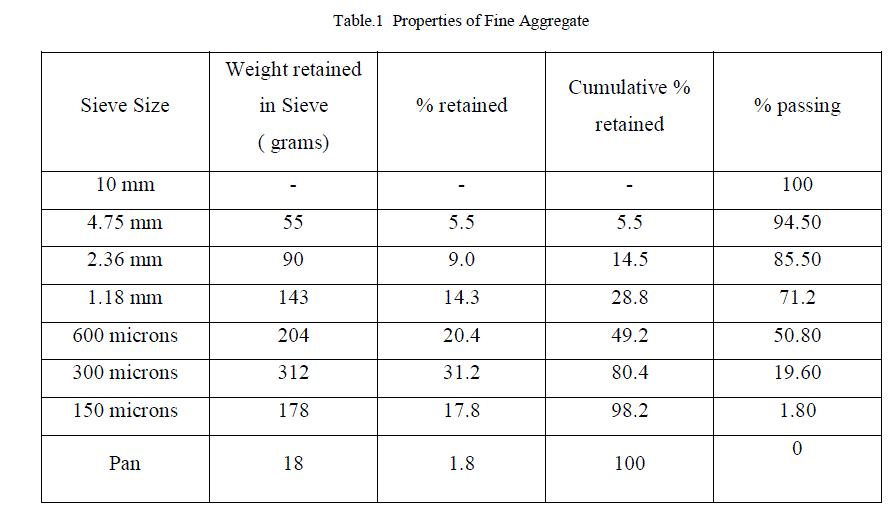 |
 |
| B. Mix Proportions of HPC: |
| For HPC there is no specific method of design mix. In the present investigation ACI method and as also the available literatures on HPC are used. In order to achieve high strength lower w/b ratio is adopted and to achieve good workability superplasticizere is used. The trial mix proportions of the concrete are shown in Table 4. In the present investigation w/b ratio used is 0.29 and dosage of Superplasticizer is 5.11 Kgs/Cum and 28 days target mean strength for all mixes was 69 Mpa. |
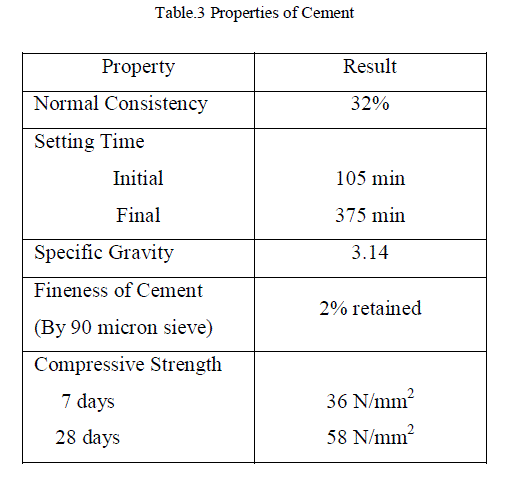 |
| C. Preparation of Test Specimens |
| Six concrete mixes were cast with replacement of 0, 5, 10, 15, 20 and 25% silica fume with cement, at a 0.29% w/b ratio. For all the mixes the ratio of cementenous matrix (Cement + Silica fume) to coarse aggregate and fine aggregate was maintained the ratio of 1:1.40:1.89. The slumps are measured and the slum values are decreased when the silica fume increases and the results are showed in Table.5. The cubes and cylinders are casted and cured in curing pond. At 7 days and 28 days (cubes of size 150 mm x 150 mm x 150 mm and cylinders of size 150 mm x 300 mm) were tested for compressive strength of cubes and compressive strength of cylinders and the results are shown in Table.6 and Table.7. The compressive strength of cubes are shown in Fig.1 |
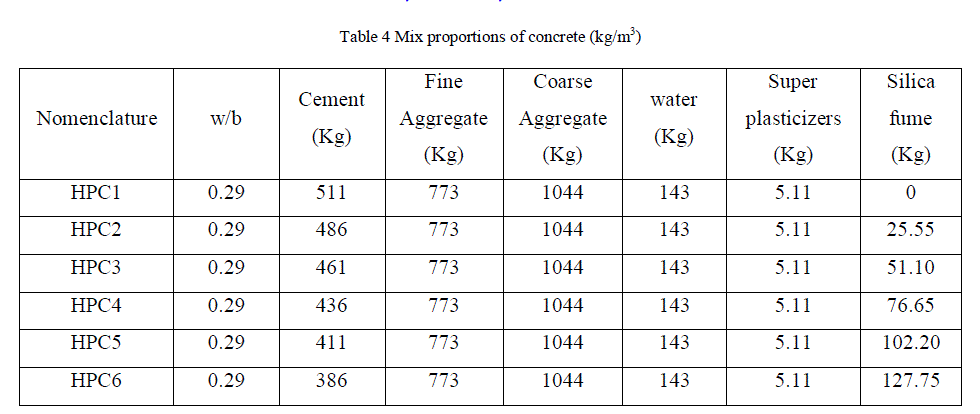 |
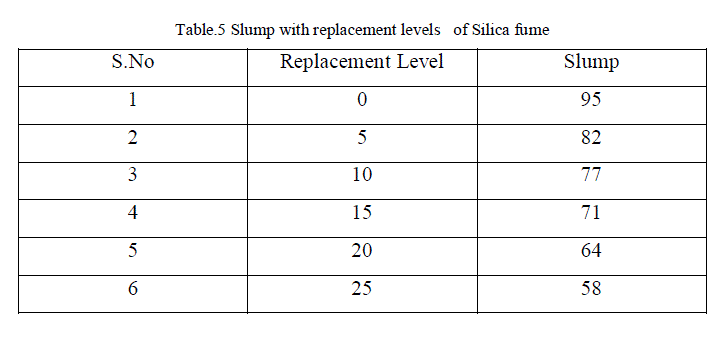 |
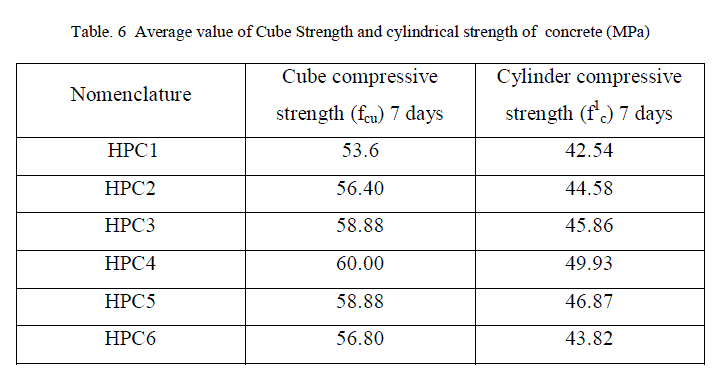 |
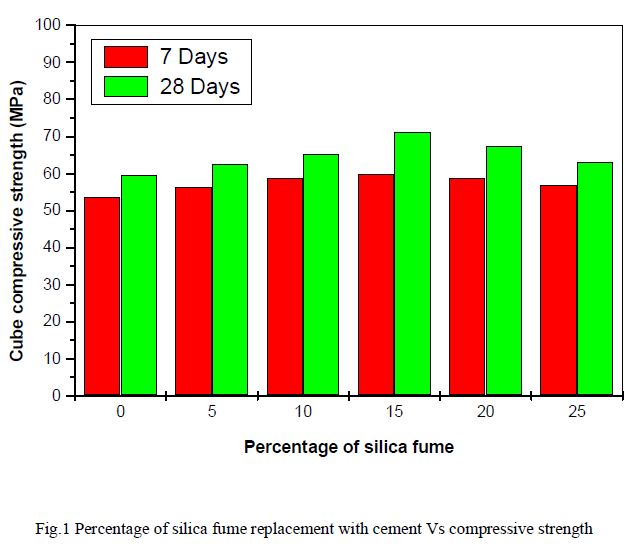 |
DISCUSSION OF TEST RESULTS |
| Replacement of cement by silica fume in HPC improved of compressive strength up to 15% replacement and after that the strength were reduced both for 7days and 28 days. This may be due to the fact that the decrease of strength is due to pozzolonic reaction and filler effect of Silica fume. |
CONCLUSION |
| The following conclusions can be made on the basis of the current experimental results. |
| 1. A mix design procedure for HPC using silica fume and super plasticizer is formulated by ACI method of mix design and available literature on HPC. |
| 2. As the silica fume content increases the compressive strength increases up to 15% [HPC4] and then decreases. Hence the optimum replacement is 15%. |
| 3. The 7 days and 28 days cube compressive strength ratio of HPC is 0.84 to 0.9 |
| 4. The percentage replacement of cement by silica fume increases, the workability decreases. |
APPENDIX |
| Mix Proportion Of M60 GradeConcrete |
STIPULATIONS FOR MIX PROPORTIONING |
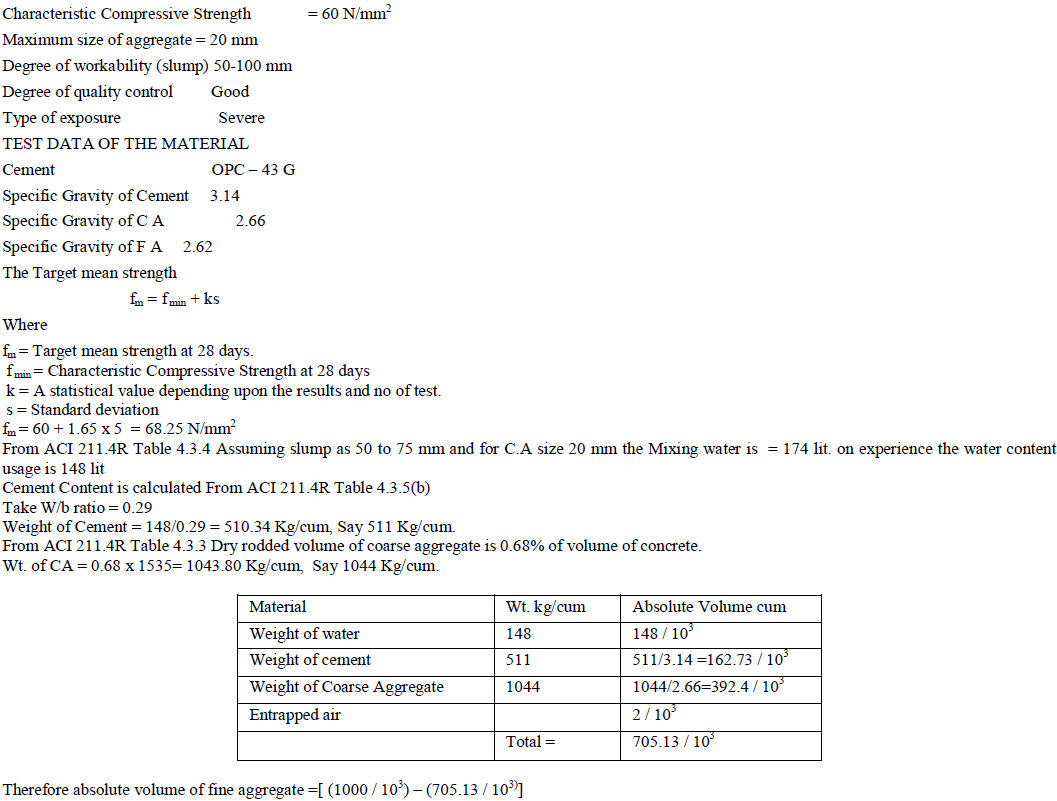 |
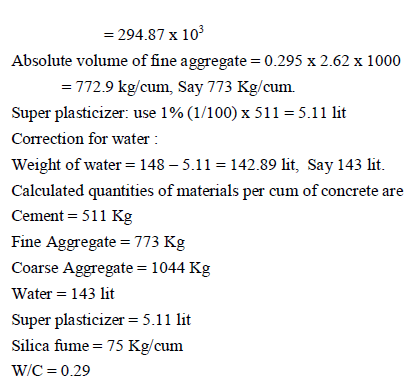 |
References |
|